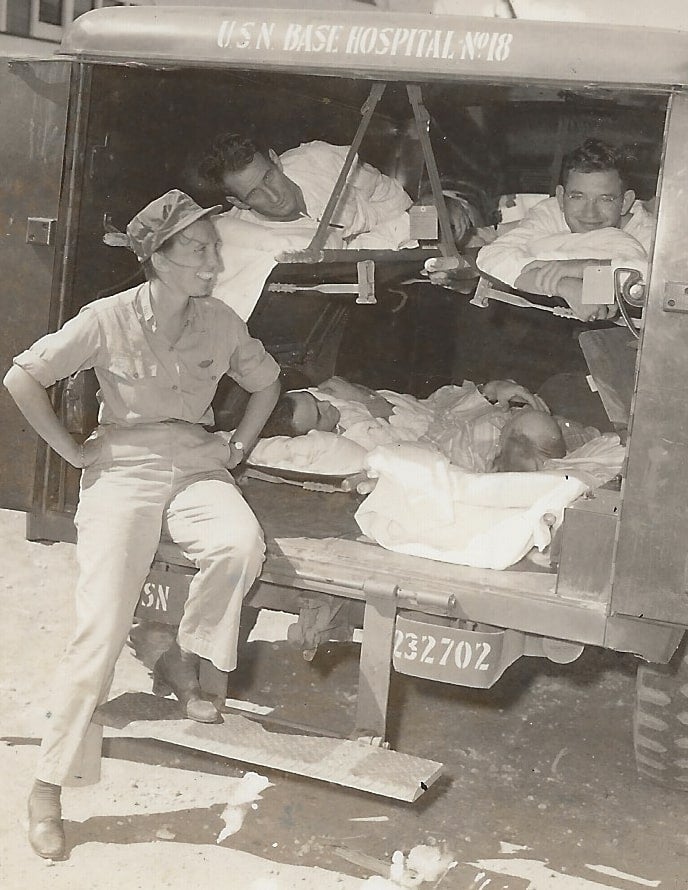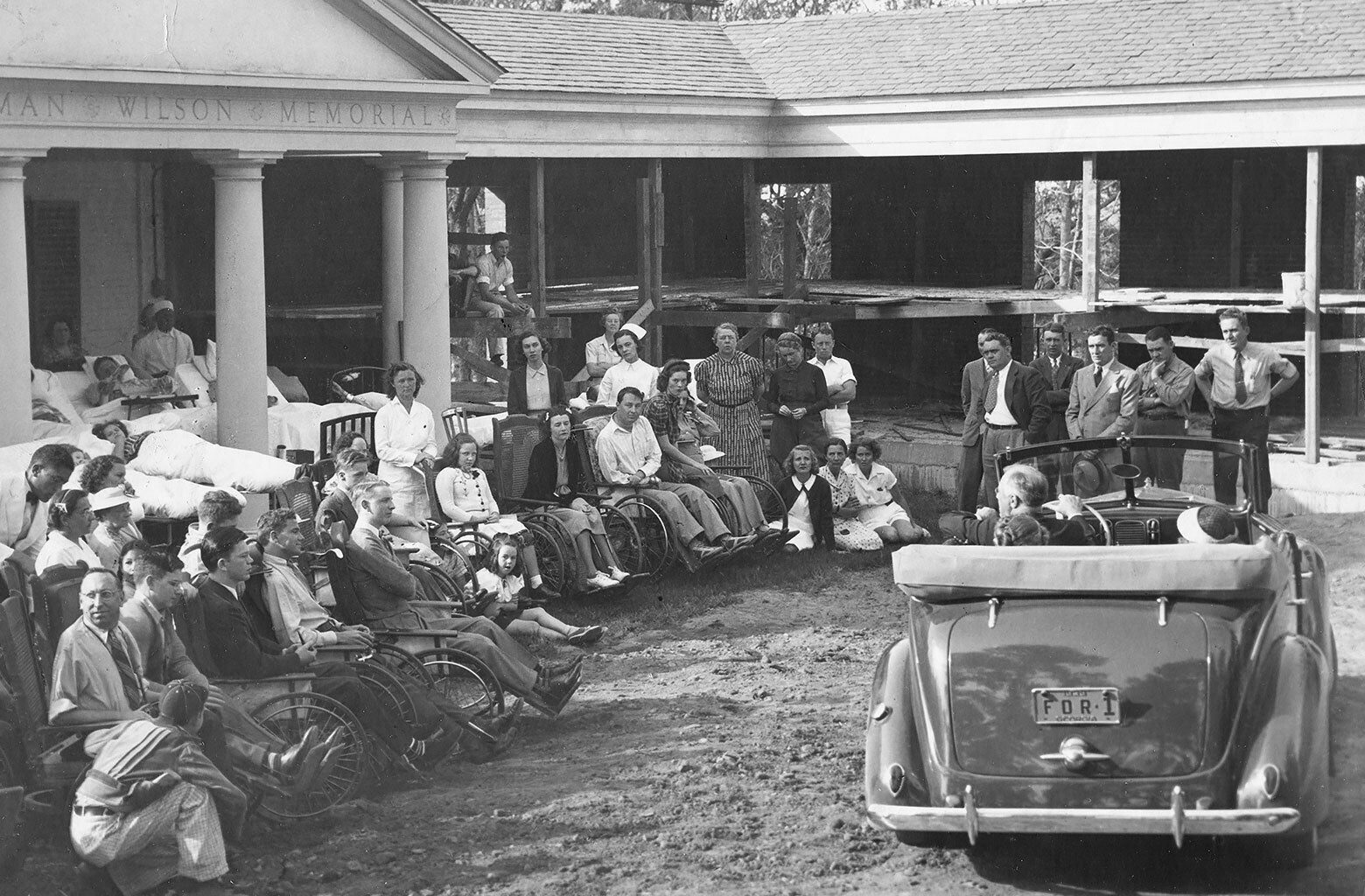Sign up for the Slatest to get the most insightful analysis, criticism, and advice out there, delivered to your inbox daily.
Polio? What polio? Uncle Lloyd doesn’t remember his sister Pat having polio. As for him, he’s walked with a cane all his life, and did he have polio? No one in his family says so. He took up sailing as a sport at Princeton—so what. He winks. See, here are the family pictures, he says. Everyone straight as string.
Pat’s résumé doesn’t suggest a polio survivor. One of the first women hired by CBS Radio, Pat Lochridge was the only female journalist to cover both the Pacific and Atlantic theaters of World War II. She interviewed Hermann Göring twice, climbed to Hitler’s redoubt at Eagle’s Nest in snow up to her waist, was the first woman reporter to participate in a landing—at Iwo Jima—and was appointed mayor of postwar Berchtesgaden.
Looking at the family photos, I see three girls in laced-up shoes, wearing knee-high white socks, no one on crutches. But later I find a photo of Pat, my mother-in-law, as a 9- or 10-year-old standing at the front of a line of girls, her half-paralyzed face much in evidence. She, like her brother, a very successful Austin lawyer, must have contracted a mild form of the disease. I telephoned the next generation of Lloyds, and Pat’s nephew said no one talked about his father’s limp, and all he ever heard about his aunt was her conquests.
Pat herself admitted she’d had polio in interviews about her adventures during WWII. Later, I find a newspaper clipping about Pat’s stint as mayor of Berchtesgaden, about how “frail” Pat was—“a victim of polio when she was a child, for years she was unable to walk.” A 1943 interview in the San Francisco Chronicle with the same reporter is titled “Handicaps, Threats Didn’t Stop Her: Patricia Lochridge Is a Correspondent.” This piece observes that 27-year-old Pat suffered “infantile paralysis in her childhood” and achieved a top spot in her profession despite the tenet that “no reporter is better than his legs.”
It’s her family that won’t affirm her having polio.
Sixty years earlier, during Texas’ pioneer days, any sign of weakness meant that the family and its wagon had to be left behind. Pat, a descendant of those pioneers, could have inherited the instinct to show no pain or impairment—or was it a more basic drive of preservation? Dogs are set upon by other dogs if they whimper. In the 1950s, the last time polio was a scourge in the U.S., families considered contracting the disease shameful. In order to catch it, you must have associated with the wrong people or gone “slumming.” The irony is that polio actually becomes dangerous when sanitation is good. People living in poorer neighborhoods develop antibodies, since you can gain immunity by ingesting the virus in small doses. But if you caught the disease and became disabled, wealthy or not, you were considered damaged and treated with less respect. Disabled family members were often put into asylums back then and left there for the rest of their lives.
Pat shrewdly used the diagnosis to her advantage. In her 1995 interview for Nancy Sorel’s The Women Who Wrote the War, she says “that the fact that she had come down with polio when young had cemented her friendship” with FDR. Pat’s “great personal friend,” as she refers to FDR, also worked hard to obscure his disability. He devised a method of “walking,” using a cane and the arm of his son or adviser for balance, and maneuvered his hips and swung his legs forward in a swaying motion. Overcompensating, he would sometimes make seven speeches a day on the campaign trail but requested that the press never photograph him walking, maneuvering, or being transferred from his car. The press took great pains to obey him. At the now-demolished Philadelphia Municipal Stadium in 1936, after he was nominated for a second term, his braces slipped as he was moved behind the speaker’s platform. He fell into the mud, and pages of his speech scattered. While his aides collected the papers and helped him to stand, Pat’s CBS colleague Robert Trout, who was providing on-the-spot radio reporting, said not a word.
Politically, FDR couldn’t be seen with a disability—only two of the 35,000 photographs in the Roosevelt Presidential Library at Hyde Park show him in a wheelchair—but it’s not as if nobody knew about it. How he coped became a powerful symbol of an individual’s persistence in managing with an impairment. He was, in part, defined by how he dealt with his disability, admired and remembered for it. “Every time I hear your voice on the radio and read about your attitude toward physical handicaps … I am strengthened and my courage is renewed,” wrote one of his constituents. Roosevelt bought Georgia’s Warm Springs resort to relieve his symptoms and occasionally led therapy sessions himself, where patients called him “Uncle Rosey.” To support the polio clinic, he organized Birthday Balls all across the country, using his date of birth as an occasion to raise money to combat the disease, the first time philanthropy was open to everyone. Radio commentator Walter Winchell provided the catchy slogan: “Dance so that a child might walk.” Six thousand balls were held in 1934, and Roosevelt raised over $1 million, nearly $20 million in today’s money, laying the groundwork for the March of Dimes, its mailbags soon full of the dimes that poured into the foundation’s office to help fund the vaccine. Eventually, FDR’s face appeared on the dime itself.

The estate of Patricia Lochridge Hartwell
On the other hand, FDR’s outrageous cousin Alice Roosevelt Longworth had polio in childhood, but the family did not disclose it. Her stepmother had insisted she wear special leg braces and shoes as a child and forced her to do physical therapy to strengthen her legs. This regimen did not endear her stepmother to Alice, and although Alice was able to walk without braces as an adult, perhaps their discord was why all mention of her polio was buried. Alice also apparently connected the humiliations of disability with social class, stating that she felt “like a tenement child … deformed with my legs.”
Ten years after FDR’s death, his foundation helped launch the nationwide inoculation program that ended the polio epidemic. Early supporter Winchell almost stopped the program. He warned that Jonas Salk’s cure “may be a killer,” suggesting on TV, on the radio, and in the newspaper that the vaccine contained live virus. He could have been extra cautious with regard to the lives of children, but his words mirrored those of the anti-vaccine movement, popularized by the Daughters of the American Revolution, the American Legion, and other right-wing organizations, that persists today, having gained new steam during COVID-19 and now being cemented into the federal government by the second Trump administration. Only in this one instance was Winchell right. A single batch was indeed not properly inactivated, and 79 children contracted polio— out of 1.8 million.
Robert F. Kennedy Jr., the new secretary of Health and Human Services, was born in 1954, the year before the polio vaccine was government-approved. One of his uncles, President John Kennedy, signed the Vaccination Assistance Act of 1962 into law, expanding the use of the few childhood vaccines available at the time. “There is no longer any reason why American children should suffer from polio, diphtheria, whooping cough, or tetanus,” Kennedy told Congress. RFK Jr. spread much misinformation about vaccines prior to his appointment, and a lawyer who helped him build a list of federal officials to nominate for the department once petitioned the Food and Drug Administration to revoke approval of the polio vaccine. RFK Jr. has no medical training—which means that, unlike doctors, he’s never sworn to do no harm.
Though the efficacy of the polio vaccine has been known for over 70 years, new HHS policy around testing may (it’s not clear yet) require the older vaccine, or new variations on it that are now being developed, to be tested using placebo trials. This is an outcome that’s still far from coming to pass, but just imagine if it did happen. There would be children assigned to the placebo group exposed to the virus; 1 in 200 in a given group of infected children would be affected to the point of irreversible paralysis, and 5 to 10 percent of that smaller subset would die. Yes, some victims do recover from mild infections well enough to sing and perform, to take up the practice of law, to report during wartime, but some do actually die. Since 80 percent of those who contract polio are children under the age of 5, those in the trial won’t have any say about their participation, signed up by parents who most likely have been vaccinated themselves.

Mark Joseph Stern
The Supreme Court Just Handed RFK Jr. New and Extraordinarily Frightening Power
Read More
Out of the nearly 2 million children who received the vaccine in 1955, only one died. Every corner of the U.S. had victims before the vaccine. Even my tiny grade school of 100 children in 1950s Nebraska had two polio victims, one of them known as “Skippy” for his gait with braces, and both dragged themselves around while the rest of us screamed and chased each other on the playground. Persuading teenagers, those near immortals, to get vaccinated was the biggest challenge. To sway them, Elvis Presley was given his shot live on Ed Sullivan’s TV program. Parents of the boomer generation rushed to get the oral vaccine for themselves and their children. The boomers, having schoolmates or friends with the disease, vaccinated their own children. Few of the next generation have seen the disease for themselves or felt its threat.
But imagine that your child is one of those who contracts polio during these new trials, if they do happen. They will also be susceptible to post-polio syndrome, which affects 15 to 80 percent of older adults who, years after the initial bout, have to suffer the disease all over again. Joni Mitchell, who didn’t have a choice whether to take the vaccine because it didn’t exist when she was exposed, contracted polio at age 9. She writes: “If [polio] eats the muscles of the heart, it kills you; if it eats the muscles that control the flexing of your lungs, you end up in an iron lung; if it eats the muscle of your leg, it withers.” She began to sing and write songs while in the hospital for polio in her spine. Mitchell has had post-polio syndrome for the past 30 years. That’s a long time to suffer for a decision somebody else made for you.
These days, celebrities who’ve had polio don’t hide their ordeal. Like Mitchell, Mia Farrow has long been involved in polio campaigns around the world, having endured being in an iron lung for eight months and had all her belongings burned. Director Francis Ford Coppola was stricken at the age of 9: “There were gurneys piled up three and four high in the hallways because there were so many more kids than there were beds in the hospital. … I remember the kids in the iron lungs who you could see their faces on mirrors, and they were all crying for their parents. They didn’t understand why they were suddenly in these steel cabinets.” Violinist Itzhak Perlman has always worn leg braces and crutches that force him to perform seated. “I never wanted people to say, ‘Well, you know, for somebody who can’t walk, he plays very well.’ ”
-
Lots of Us Forget How Bad Life Was Before Vaccines. I Have a Theory About That.
-
It’s Basically the Worst Flavor You Can Find in Wine. So Why Are Some Winemakers Embracing It?
-
This Content is Available for Slate Plus members onlyFresh Herbs Are Being Massively Mismanaged in Many Recipes. But I’ve Discovered a Brilliant Solution.
-
Growing Up, I Didn’t Realize I Was Gay. Then Seven Straight Guys and I Went to Colonial Williamsburg.
There is yet another hidden affliction that polio survivors suffer, which is emotional. In an essay in the Washington Post, Elizabeth Evitts Dickinson writes about her polio-stricken mother who, as a child, spent a year in the hospital with the disease. She recovered so well she danced the ballet and became a poster child for the March of Dimes. Her mother told a reporter that she was determined “to live her life so that no one would notice she’d ever been sick,” perfectly reflecting Pat’s practice. “But she never really fully recovered,” writes her daughter, as “polio paralyzed more than her body.” Dickinson believed that the early experience of isolation and abandonment—her parents were allowed to visit only on Sundays—severely affected her psyche. Her mother rarely hugged her, or held hands, or kissed her, a state of affairs that my husband remembers only too well with regard to his mother.
Like FDR, Pat excelled in the outside world, and perhaps, like him, as a result of her disability. She prioritized strength over truth and fabricated her wellness. Her parents wanted to put her and her brother’s strengths ahead of their disabilities, until they could decide for themselves what to tell people. The irony was that she was driven to report the truth of what she saw as a reporter, but her family felt obliged to cover up the truth of her body. Never did she talk about having polio in the 19 years I knew her as my mother-in-law. Was she hospitalized as a young child, torn from her family, and mocked when she returned to school for her half-frozen face? Did she have post-polio syndrome in old age? She did not complain. When families minimize the effects of polio, it makes it harder for the rest of us to fight off the anti-vaxxers.

Sign up for Slate’s evening newsletter.
